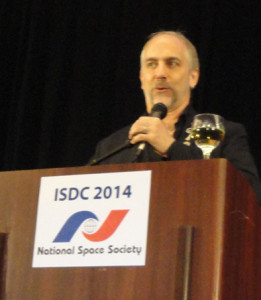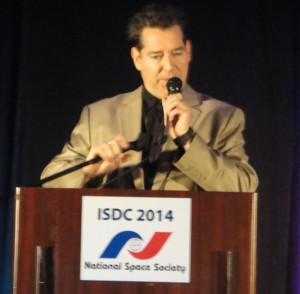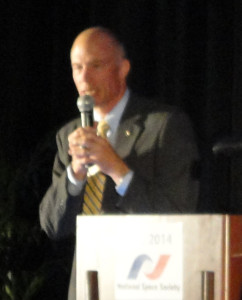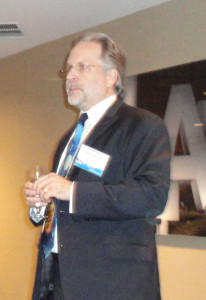ISDC 2014 kicked off with an evening reception. Richard Garriott, private astronaut, video game entrepreneur and vice-chairman of Space Adventures, Ltd, presented two movies: “Man on a Mission” and “Apogee of Fear.” “Man on a Mission” chronicles his quest to open civilian spaceflight. Garriott, along with many partners, opened civilian spaceflight for all, through a series of companies and successes and failures. This ultimately led to his becoming the 1st second-generation astronaut (Garriott’s father is NASA astronaut Owen Garriott). “Apogee of Fear” is the first science fiction movie filmed and premiered in space, starring Garriott along with cosmonaut Yuri Lonchakov and astronauts Michael Fincke and Greg Chamitoff aboard the International Space Station. Click here to see “Apogee of Fear” on youtube.
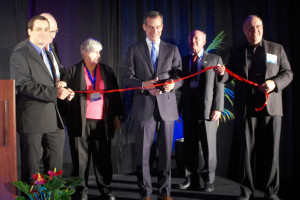
Los Angeles Mayor Eric Garcetti (center) cuts the ribbon opening ISDC 2014 as (from left) co-chair Nicola Sarzi-Amade, MC Ivan Rosenberg, chair Pat Montoure, keynote speaker David Gorney, and co-chair John Spencer look on. (Photo: Michael McGuire)
May 15 was the first full day of ISDC. Master of Ceremonies Ivan Rosenberg, President and CEO, Frontier Associates, Inc., and Co-founder and Executive Director of the Aerospace & Defense Forum, introduced the Mayor of Los Angeles, Eric Garcetti. The Mayor spoke about how ISDC 2014 is a unique opportunity to promote Los Angeles and Southern California as a great place for aerospace companies and the growing “New Space Companies.” He then performed a ribbon-cutting ceremony for the official opening of ISDC 2014, along with chair Pat Montoure and co-chairs Nicola Sarzi-Amade and John Spencer. Garcetti was followed by David Gorney, VP of Space Programs Operations at The Aerospace Corporation. Gorney spoke on the current state of the aerospace and defense industry in Southern California. He described how, despite tight budgets and rising costs, there is still plenty of room for innovation and reinvention in both the private and public sectors.
At Thursday’s luncheon, Geoffrey Notkin (meteorite expert and star of the Science Channel’s adventure series “Meteorite Men”) spoke on “Meteorites and Me – We’re Not From Around Here”. That evening, Jeff Greason (CEO and Chairman of the Board of Directors, XCOR) was the keynote speaker: “Government and Private Roles in Space Settlement.” The dinner also featured the presenting of the Space Pioneer Award Space Pioneer Award in the Science and Engineering category to Professor John S. Lewis, Professor Emeritus of Planetary Sciences and Co-Director of the Space Engineering Research Center at the University of Arizona.
Thursday concluded with a screening of “Three Nights, Three Days,” produced by David Knight (CEO, The Terbine Project) and Melissa Eccles (Immersive Entertainment). Three Nights, Three Days tells how the people of Los Angeles came together to shepherd the Space Shuttle Endeavour through its often-troubled streets. With only four space shuttles to allocate across the US, NASA supplied this national treasure to America’s second-largest city under the instruction that she be immediately placed on public display. Faced with the daunting challenge of squeezing a huge priceless object through nearly 13 miles of relatively narrow roads to the California Science Center, literally thousands of engineers, law enforcement representatives and volunteers pulled it off against considerable odds.

“The Birth of a Thriving Commercial Space Economy.” (from left) Moderator Bruce Pittman, Robert Richards, Dan Rasky, Chuck Lauer, Rick Tumlinson, William Pomerantz, Jeff Greason. (Photo: Michael McGuire)
Friday morning opened with a panel, “The Birth of a Thriving Commercial Space Economy.” The panel explored various aspects of the shift from the birth of a commercial suborbital tourism market to mining the moon and the asteroids for water and precious metals, as well as examining new ways for government and industry to work together. The panelists were Dr. Robert Richards (co-founder of the International Space University), Jeff Greason, Chuck Lauer (VP of Business Development for Rocketplane, Inc.), Rick Tumlinson (Chairman of the Board at Deep Space Industries), William J. Pomerantz (VP for Special Projects, Virgin Galactic), Dr. Dan Rasky (director and co-founder of the Space Portal at the NASA Research Park, Moffett Field). Bruce Pittman served as moderator (Senior VP and Senior Operating Officer of the NSS).
Friday lunch featured the Orbital Sciences Antares/Cygnus Team, represented by Frank DeMauro (VP and Program Director, CRS Program) and Mike Laidley (Program Director, Antares). They spoke on the development of the Antares Launch Vehicle, the new launch site at Wallops Flight Facility, and the Cygnus advanced maneuvering spacecraft. The presentation described Orbital’s partnership with NASA on the Commercial Orbital Transportation Services (COTS) program and the challenges and accomplishments of the program, which culminated in a successful rendezvous and cargo delivery to the ISS. Following their presentation, the team received the Space Pioneer Award for the Science and Engineering category.
The Governors’ Dinner on Friday night featured Colonel Rick Searfoss, test pilot for XCOR, as the keynote speaker. His presentation had the amusing, though on-point, title “Space Renaissance: Rebirth as a Bouncing Beaming Baby or Screaming Little Monster?” Searfoss also presented the 15th Biennial Robert Heinlein Award to Elon Musk. Following the Heinlein Award was the presentation of the Space Pioneer Award for the Science and Engineering category to the Mercury MESSENGER Team.
Saturday morning opened with a panel presentation: “Asteroids for Life, Then and Now”, featuring Howard Bloom (author and NSS Board of Governors member), Professor John S. Lewis (see Space Pioneer Award Winners), Michael Nolan (Arecibo Observatory), Seth Shostak (SETI Institute), William Ailor (The Aerospace Corporation), and moderator Laura Danly (Griffith Observatory). The panel provided an overview of asteroids, both as a threat and in terms of resources, discussed in the context of today’s scientific, economic, political, and social climate.
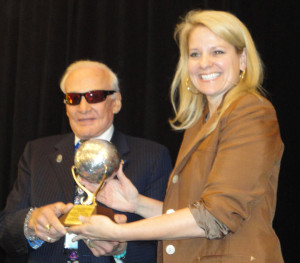
Buzz Aldrin presents the Space Pioneer Award for Entrepreneurial Business to Gwynne Shotwell. (Photo: Seth Potter)
Lunch that day featured SpaceX CEO Gwynne Shotwell receiving the Space Pioneer Award for Entrepreneurial Business from Buzz Aldrin. Aldrin then presented “Buzz Aldrin’s Unified Space Vision,” which featured his Aldrin Cycler scheme for getting astronauts to Mars and back.
That afternoon, Mat Kaplan of the Planetary Society hosted a Planetary Radio live show. The show is part of the Planetary Society’s weekly public radio and podcast series, featuring the latest stories in space exploration and development. Planetary Radio airs on 150 radio stations and Sirius XM Satellite Radio.
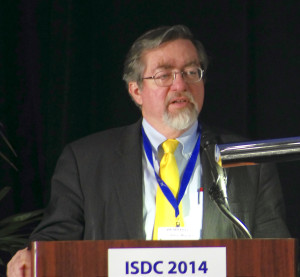
John Mankins makes “The Case for Space Solar Power” at the Space Renaissance Celebration (Photo: Michael McGuire)
Saturday evening was a special night: a Space Renaissance Celebration. The festivities began with a VIP reception featuring speaker Taber MacCallum, co-founder and Chief Technology Officer of Paragon and World View, and CEO of Paragon. A dinner followed the reception, at which MacCallum spoke again, on “Sea Change in the Space Industry”. John Mankins (Founder and CEO of SolarThermoChemical LLC, President of Artemis Innovation Management Solutions LLC, and CTO of Deep Space Industries, Inc) made “The Case for Space Solar Power,” and Master of Ceremonies Mark Hopkins continued the call for the development of space solar power in his address.
Professor Don Flournoy of Ohio University then presented awards to the International Sunsat Design Competition winners. SunSat Design is an international competition intended to accelerate the conceptualization, manufacture, launch and operation of the next-generation satellites that will collect energy in space and deliver it to Earth as a non-polluting source of electrical power. Click here to read more about the Competition and the winners.
This was followed by the presenting of the Grand Prizes for the NASA/NSS Space Settlement Design Competition. NASA Ames Research Center in conjunction with the National Space Society sponsors an annual space settlement design contest for 6th-12th grade students. Each spring, students send their designs for homes in space for judging by NASA engineers and scientists. The contest has inspired thousands of students and helped hundreds of teachers bring the excitement of space settlement to the youth of America and the world. Click here to read more about the Competition and the winners.
The Space Renaissance celebration also featured the premiere of NSS’ Kickstarter Project Movie. The video includes interviews with space proponents ranging from artists to astronauts, scientists to students, and engineers to entrepreneurs. They explain why space is important to them and to humanity, and how everyone can be involved. The video is aimed at a wide range of audiences: for example, students, investors, civic groups and Congressional representatives.
The celebration concluded with a party themed “Space is Sexy”, with a cover band, an LED-lit “fire” dancer, and costumed partygoers (including Mark Hopkins, as Captain Kirk – he probably doesn’t like wearing red).
Sunday, May 18
Sunday morning, the last day of ISDC 2014, kicked off with Naveen Jain, co-founder of Moon Express. Jain articulated his belief in the long-term economic potential of the Moon to produce resources essential to Earth’s energy future. Moon Express, a Google Lunar XPRIZE Foundation finalist, plans to send a series of robotic spacecraft to the Moon for ongoing exploration and commercial development focused on benefits to Earth, and has signed a partnership agreement with NASA for development of a lunar lander system.
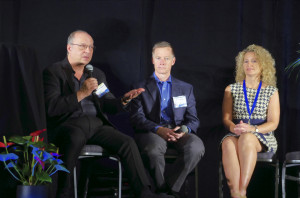
“NASA Partners with Industry on Commercial Crew to Orbit” (from left) John Spencer, Chris Ferguson, and Pam Underwood. (Photo: Michael McGuire)
A panel presentation followed: “NASA Partners with Industry on Commercial Crew to Orbit” with Chris Ferguson (shuttle astronaut and Director of Crew and Mission Operations in the Boeing Commercial Crew program), Pam Underwood (Office of Commercial Space Transportation [FAA/AST]), and John Spencer (president of the Space Tourism Society). Ferguson said Boeing hopes that political differences between the United States and Russia over Ukraine will be resolved by the time the company is ready to launch its CST-100 spacecraft on a test flight in early 2017, thereby resolving differences over extended operation of ISS. Spencer expressed hope that luxury super space yachts would be cruising Earth orbit and the cislunar region, with televised races between them. Ferguson also saw commercial ventures extending beyond Earth orbit, with lunar missions and the construction of a base on the moon’s surface.
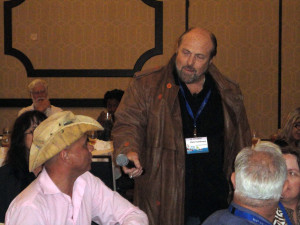
Rick Tumlinson asking an audience member “How did you get interested in space?” (Photo: Seth Potter)
Sunday’s lunch, emceed by Anita Gale (NSS Board of Directors and an OASIS member since even before the NSS formed), featured speaker Rick Tumlinson. He ended ISDC 2014 with a bang: “SpaceMap – An Integrated Plan for the Exploration and Settlement of Space.” Tumlinson began by asking audience members what first got them interested in space – answers ranged from the Apollo missions to the space shuttle program. He later contrasted explorers with settlers, citing various examples from history. Tumlinson asked why people want to go into space—for economics, or exploration, or survival of the species? He stated that the real reason people want to go into space is “because we want to.”
ISDC 2014 concluded with SpaceUp, an “unconference” that brought aerospace industry professionals together with students and local enthusiasts to talk informally about their ideas for space travel, access, and exploration. Participants got the chance to demonstrate their space-related projects with the community, run their own sessions, get feedback on their ideas, or simply listen.
ISDC 2014 participants left the conference inspired to continue the “Space Renaissance.”

